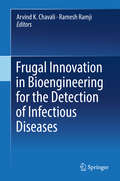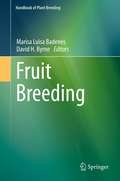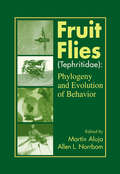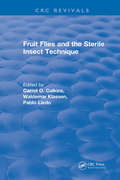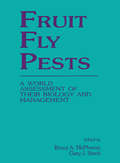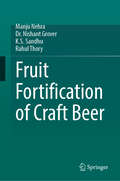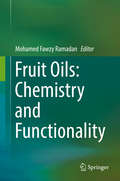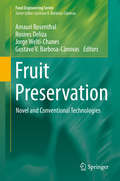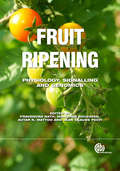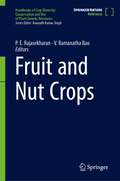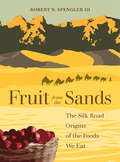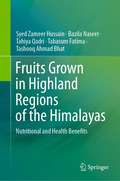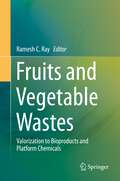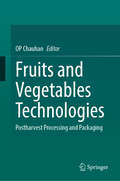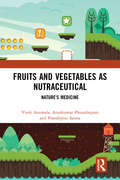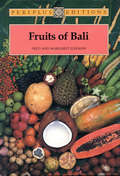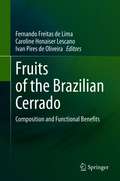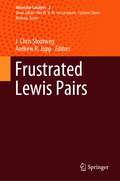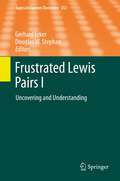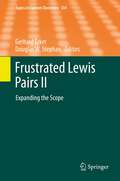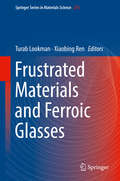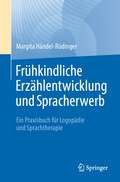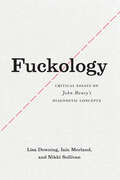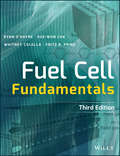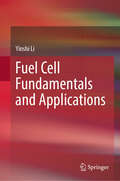- Table View
- List View
Frugal Innovation in Bioengineering for the Detection of Infectious Diseases
by Arvind K. Chavali Ramesh RamjiThis book introduces readers to the concept of 'frugal innovation' and describes novel low-cost technologies that aid in diagnosing infectious diseases. Rapidly deployable, portable, and affordable diagnostic tools have the potential to tremendously benefit populations in resource-limited settings and improve global health outcomes. Specifically, the book includes the following features: Cutting-Edge Research: Thorough coverage of scientific advances related to frugal bioengineering that have been developed within the last few years. A few examples of technologies covered in detail include low-cost paper-based and CD-based microfluidic diagnostic systems. Industry and Non-Profit Voices: Chapters written by scientists currently working in industry and philanthropic sectors.
Fruit Breeding
by Maria Luisa Badenes David H. ByrneFruit Breeding is the eighth volume in the Handbook of Plant Breeding series. Like the other volumes in the series, this volume presents information on the latest scientific information in applied plant breeding using the current advances in the field, from an efficient use of genetic resources to the impact of biotechnology in plant breeding. The majority of the volume showcases individual crops, complemented by sections dealing with important aspects of fruit breeding as trends, marketing and protection of new varieties, health benefits of fruits and new crops in the horizon. The book also features contributions from outstanding scientists for each crop species. Maria Luisa Badenes Instituto Valenciano de Investigaciones Agrarias (IVIA), Valencia, Spain David Byrne Department of Horticultural Sciences, Texas A&M University, College Station, TX, USA
Fruit Flies (Tephritidae): Phylogeny and Evolution of Behavior
by Martín Aluja Allen L. NorrbomFruit flies (Diptera: Tephritidae) are among the most destructive agricultural pests in the world, eating their way through acres and acres of citrus and other fruits at an alarming rate and forcing food and agriculture agencies to spend millions of dollars in control and management measures. But until now, the study of fruit flies has been traditi
Fruit Flies and the Sterile Insect Technique
by Carrol O. CalkinsThis book is a continuation of the development of the Sterile Insect Technique (SIT) specifically designed for use against, and management of, fruit flies. Several factors indicate an increased use of the SIT against fruit flies within the next decade.
Fruit Fly Pests: A World Assessment of Their Biology and Management
by Bruce A. McPheron; Gary J. SteckA book of national and international importance, Fruit Fly Pests is an exhaustive compendium of information (with data provided by more than 100 contributors) that will appeal to a wide variety of readers. With huge losses experienced annually from fruit fly devastation, information on these high-profile insects is important to commercial fruit and vegetable growers, marketing exporters, government regulatory agencies, and the scientific community. Fruit flies impose a considerable resource tax, and the ones who suffer range from shippers to end users. The demand for world-wide plant protection requires up-to-date research information. This book meets that need.This book contains the proceedings from the most recent International Symposium on Fruit Flies of Economic Importance. Here you will find the major presentations given at the symposium, with an added feature - overviews from experts on topics not covered directly by participants in the symposium, filling in gaps in the current literature. The resulting publication is the most up-to-date and readable text to be found anywhere on the subject of tephritids.
Fruit Fortification of Craft Beer
by Manju Nehra Nishant Grover K.S. Sandhu Rahul ThoryBeer has been one of the staples in alcohol consumption since the earliest civilizations. In the present day, beer is more popular than ever and shows no signs of decreasing in production volume and revenue generation. Some of the most popular craft beer types utilize fruit raw materials in their production, including wheat beers, porters, high gravity beers, stouts and Lambics. There have been multiple sources published over the decades focusing on beer brewing and brewing science, many of which do cover fruit fortifications and craft beer production. Due to the increasing popularity of fruit-fortified craft beers, an updated singular source is needed focusing on the use of fruit raw materials in the brewing process for various types of craft beer. Fruit Fortification of Craft Beer extensively outlines the use of fruits in the brewing and malting processes for all types of popular craft beers, outlining the latest technological and processing advances. Various fruit material additives are covered as are their specific uses in the brewing process, their characteristics and processing methods. The main types of craft beers which utilize fruit additives are covered including their chemical profiles and nutritional aspects. A major aspect of this book is the linking of the past and the future, examining how fruit has been used in beer fortification since ancient times and how the technologies and processing methods have advanced with the increasing popularity of locally-brewed craft beers. In focusing on these advances, this work brings fruit fortification in craft beers up to the present, providing an in-depth source for researchers and brewers.
Fruit Oils: Chemistry and Functionality
by Mohamed Fawzy RamadanFruit Oils: Chemistry and Functionality presents a comprehensive overview of recent advances in the chemistry and functionality of lipid bioactive phytochemicals found in fruit oils. The chapters in this text examine the composition, physicochemical characteristics and organoleptic attributes of each of the major fruit oils. The nutritional quality, oxidative stability, and potential food and non-foodapplications of these oils are also extensively covered. The potential health benefits of the bioactive lipids found in these fruit oils are also a focus of this text. For each oil presented, the levels of omega-9, omega-6 and omega-3 fatty acids are specified, indicating the level of health-promoting traits exhibited in each. The oils and fats extracted from fruits generally differ from one another both in terms of their major and minor bioactive constituents. The methods used to extract oils and fats as well as the processing techniques such as refining, bleaching and deodorization affect their major and minor constituents. In addition, different post-processing treatments of fruit oils and fats may alert or degrade important bioactive constituents. Treatments such as heating, frying, cooking and storage and major constituents such as sterols and tocols are extensively covered in this text. Although there have been reference works published on the composition and biological properties of lipids from oilseeds, there is currently no book focused on the composition and functionality of fruit oils. Fruit Oils: Chemistry and Functionality aims to fill this gap for researchers, presenting a detailed overview of the chemical makeup and functionality of all the important fruit oils.
Fruit Preservation: Novel And Conventional Technologies (Food Engineering Series)
by Jorge Welti-Chanes Gustavo V. Barbosa-Cánovas Amauri Rosenthal Rosires DelizaFruits and fruit based products are, in most cases, associated with very good sensory characteristics, health, well-being, perishability, relatively easy to mix with food products of diverse origin, amenable to be processed by conventional and novel technologies. Given the multiplicity of aspects whenever fruit preservation is considered, the editors took the challenge of covering in a thorough, comprehensive manner most aspects dealing with this topic.To accomplish these goals, the editors invited well known colleagues with expertise in specific disciplines associated with fruit preservation to contribute chapters to this book. Eighteen chapters were assembled in a sequence that would facilitate, like building blocks, to have at the same time, a birds-eye view and an in-depth coverage of traditional and novel technologies to preserve fruits.Even though processing took center stage in this book, ample space was dedicated to other relevant and timely topics on fruit preservation such as safety, consumer perception, sensory and health aspects.FEATURES:Traditional and Novel Technologies to Process FruitsMicrowavesOhmic HeatingUV-C lightIrradiationHigh PressurePulsed Electric FieldsUltrasoundVacuum ImpregnationMembranesOzoneHurdle TechnologyTopics Associated with Fruit PreservationSafetyNutrition and HealthConsumer PerceptionSensoryMinimal ProcessingPackagingUnit Operations for Fruit ProcessingCooling and FreezingDehydrationFrying
Fruit Ripening: Physiology, Signalling and Genomics
by Christopher Davies Véronique Cheynier Autar Handa Don Grierson Asaph Aharoni Angelos Kannellis Cornelius Barry Mathilde Causse Arun Sharma Hiroshi Ezura Alisdair Fernie Kunsog Chen Joseph Hirschberg Mark Tucker Kailash Bansal Jim Giovannoni Christophe Rothan Giovanni Giuliano Abhaya DandekarFruit ripening is an important aspect of fruit production. The timing of it affects supply chains and buying behaviour, and for consumers ripeness not only affects perceptions of health but has nutritional effects too. Ripeness is closely related to spoilage which has a major financial impact on agricultural industries. Currently there are fast moving developments in knowledge of the factors affecting fruit ripeness, and this up-to-date monograph seeks to draw together the disparate research in this area. The aim of the book is to produce a comprehensive account covering almost every area related to fruit ripening including the latest molecular mechanisms regulating fruit ripening, its impact on human nutrition and emerging research and technologies.
Fruit and Nut Crops (Handbooks of Crop Diversity: Conservation and Use of Plant Genetic Resources)
by P. E. Rajasekharan V. Ramanatha RaoFruit and Nut Crops: A Treasure Trove of Diversity and ResilienceDive into the fascinating world of fruit and nut crops in this comprehensive volume. Explore their origins, evolution, and global journey, from wild ancestors to diverse cultivars nourishing us today. Uncover their crucial role in food security, providing vital nutrients and supporting livelihoods.This book champions urgent conservation efforts in the face of threats like habitat loss and climate change. It delves into both ex situ and in situ strategies, emphasizing the importance of preserving genetic diversity for the future. Learn about domestication processes and the development of gene pools adapted to specific environments.Discover the economic and social benefits of utilizing fruit and nut genetic resources, from breeding programs that empower communities to innovative techniques for enhancing yields and quality. This invaluable resource equips researchers, breeders, and policymakerswith the knowledge to safeguard and advance this critical agricultural sector
Fruit from the Sands: The Silk Road Origins of the Foods We Eat
by Robert N. Spengler IIIThe foods we eat have a deep and often surprising past. From almonds and apples to tea and rice, many foods that we consume today have histories that can be traced out of prehistoric Central Asia along the tracks of the Silk Road to kitchens in Europe, America, China, and elsewhere in East Asia. The exchange of goods, ideas, cultural practices, and genes along these ancient routes extends back five thousand years, and organized trade along the Silk Road dates to at least Han Dynasty China in the second century BC. Balancing a broad array of archaeological, botanical, and historical evidence, Fruit from the Sands presents the fascinating story of the origins and spread of agriculture across Inner Asia and into Europe and East Asia. Through the preserved remains of plants found in archaeological sites, Robert N. Spengler III identifies the regions where our most familiar crops were domesticated and follows their routes as people carried them around the world. With vivid examples, Fruit from the Sands explores how the foods we eat have shaped the course of human history and transformed cuisines all over the globe.
Fruits Grown in Highland Regions of the Himalayas: Nutritional and Health Benefits
by Syed Zameer Hussain Bazila Naseer Tahiya Qadri Tabasum Fatima Tashooq Ahmad BhatThis book discusses different fruit crops and provides first-hand information on the nutritional composition of commercially important, as well as unexplored fruits, which are grown in Jammu, Kashmir and Ladakh. A detailed nutritional profile of each fruit is presented in the book. The potential health implications against cardiovascular diseases, diabetes, carcinoma, oxidative damage, asthma, aging and cognition are discussed and explained. Besides, nutritional composition and medicinal implications, origin, morphology, taxonomy and production scenarios of unexplored, as well as commercially important fruits, have also been highlighted in the book. This book will be of interest to students and researchers involved in agricultural sciences, food science, nutrition and the Indian medicine system.
Fruits and Vegetable Wastes: Valorization to Bioproducts and Platform Chemicals
by Ramesh C. RayThis book puts together all aspects of valorization of vegetable and fruit wastes (VFWs) into different biocommodities and platform chemicals using fermentation and non-fermentation processes. VFWs are a special group of solid waste (biomass) that needs to be characterized to understand the nature of applications as raw materials and to propose an appropriate methodology for bioprocessing into value-added commodities. VFWs provide favorable conditions for the growth of microorganisms, and this opens up great opportunities for their use in fermentation processes. For example, VFWs can be used as a solid support, carbon, and nutrient source in fermentation for the production of a variety of value-added biocommodities such as enzymes, single-cell proteins, bioadsorbents, phenolic bioactive compounds, aroma and flavor compounds, and platform chemicals like lactic acid, bioethanol, and biobutanol. Researchers and academics in the area of environmental science and engineering, chemical engineering, biotechnology, life science, and food science and technology, undergraduate and graduate students, industry professionals, and policymakers will find this publication useful. Bioprocessing of agro-wastes is a recent technology for developing novel bioproducts. This book will also be of interest to the general public as a reference for all those interested in waste management.
Fruits and Vegetables Technologies: Postharvest Processing and Packaging
by Op ChauhanThis book presents the latest postharvest technologies for fruits and vegetables, focusing on the innovations in processing and packaging. It reviews various techniques, including dehydration, low-temperature preservation, freezing, non-thermal processing, and modified atmosphere packaging. Featuring contributions from leading experts, the volume also addresses unit operations and minimal processing methods, ensuring the quality and longevity of produce. Key concepts include the physiology and ripening of fruits and vegetables, postharvest handling, and non-destructive quality monitoring. The book also addresses the creation of fruit-based products like jams, jellies, juices, and sauces, offering insights into both traditional and modern preservation methods. Readers will understand the challenges and solutions in maintaining the freshness and nutritional value of produce from farm-to-table. The book is a valuable resource for students, researchers, and food industry professionals involved in postharvest technology.
Fruits and Vegetables as Nutraceutical: Nature's Medicine
by Vivek Anumala Arunkumar Phurailatpam Pranabjyoti SarmaCognizing the significance of fruits and vegetables in the human diet. This book is designed to provide an insight into the nutritional importance of fruits and vegetables in human health, disease prevention, managing stress and boosting immunity, especially in this COVID-19 pandemic. The book contains a very concise and precise information on nutraceuticals, their sources and benefits. It also contains the best possible information regarding common health issues faced by humans and their prevention with the help of bioactive compounds, maintaining a focus throughout on how nutraceuticals influence human health. The information provided in this book is truly based on scientific records of scientists working in the arena of bioactive compounds of fruits and vegetables and their role in disease prevention of humans as well as Food Safety and Standards Authority of India (FSSAI) acts and regulations.Note: Taylor & Francis does not sell or distribute the hardback in India, Pakistan, Nepal, Bhutan, Bangladesh and Sri Lanka.
Fruits of Bali
by Fred B. Eiseman Margaret EisemanBali's Succulent Tropical Fruits make a vivid ans lasting impression on every visitor. Fruits of Bali is a field guide to this cornucopia of exotic shapes, tastes, and smells - providing photographs and descriptions of some 50 varieties, as well as fascinating botanical and background information and tips on buying and preparing the fruits yourself. Even familiar fruits acquire a distinct taste and texture in the island's tropical environment, and those unique to the region provide a surprising and delicious experience.
Fruits of the Brazilian Cerrado: Composition and Functional Benefits
by Fernando Freitas de Lima Caroline Honaiser Lescano Ivan Pires de OliveiraFruits of the Brazilian Cerrado: Composition and Functional Benefits describes the nutritional, chemical and physical characteristics of the fruits of the Cerrado, as well as their pharmacological effects and use in phytotherapics. Chapters are dedicated to the morphological characteristics, macronutrients, micronutrients and active compounds of various fruits, with separate sections covering their peels, leaves, nuts, pulps, and other components.The text also includes detailed studies on the treatment of diseases with these natural products, as well as their applications in popular use by local communities. Authors explain the importance of bioactive compounds found in the fruits and their possible mechanisms of action in the organism. This text thus provides a valuable reference to researchers studying a range of topics, including functional foods, phytotherapy, and plant science.
Frustrated Lewis Pairs (Molecular Catalysis #2)
by J. Chris Slootweg Andrew R. JuppThis volume highlights the latest research in frustrated Lewis pair (FLP) chemistry and its applications. The contributions present the recent developments of the use of FLPs in asymmetric catalysis, polymer synthesis, homogeneous and heterogeneous catalysis, as well as demonstrating their use as a pedagogical tool. The book will be of interest to researchers in academia and industry alike.
Frustrated Lewis Pairs I
by Gerhard Erker Douglas W. StephanDiscovery of Frustrated Lewis Pairs: Intermolecular FLPs for Activation of Small Molecules, by Douglas W. Stephan Intramolecular Frustrated Lewis Pairs: Formation and Chemical Features, by Gerald Kehr, Sina Schwendemann, Gerhard Erker Frustrated Lewis Pair Mediated Hydrogenations, by Douglas W. Stephan, Gerhard Erker Amine-Borane Mediated Metal-Free Hydrogen Activation and Catalytic Hydrogenation, by Victor Sumerin, Konstantin Chernichenko, Felix Schulz, Markku Leskelä, Bernhard Rieger, Timo Repo Hydrogen Activation by Frustrated Lewis Pairs: Insights from Computational Studies, by Tibor András Rokob, Imre Pápai Quantum Chemistry of FLPs and Their Activation of Small Molecules: Methodological Aspects, by Birgitta Schirmer, Stefan Grimme Computational Design of Metal-Free Molecules for Activation of Small Molecules, Hydrogenation, and Hydroamination, by Zhi-Xiang Wang, Lili Zhao, Gang Lu, Haixia Li, Fang Huang Computational Studies of Lewis Acidity and Basicity in Frustrated Lewis Pairs, by Thomas M. Gilbert Solid-State NMR as a Spectroscopic Tool for Characterizing Phosphane - Borane Frustrated Lewis Pairs, by Thomas Wiegand, Hellmut Eckert, Stefan Grimme
Frustrated Lewis Pairs II: Expanding the Scope
by Gerhard Erker Douglas W. StephanFrustrated Lewis Pairs: From Dihydrogen Activation to Asymmetric Catalysis, by Dianjun Chen, Jürgen Klankermayer Coexistence of Lewis Acid and Base Functions: A Generalized View of the Frustrated Lewis Pair Concept with Novel Implications for Reactivity, by Heinz Berke, Yanfeng Jiang, Xianghua Yang, Chunfang Jiang, Subrata Chakraborty, Anne Landwehr New Organoboranes in "Frustrated Lewis Pair" Chemistry, by Zhenpin Lu, Hongyan Ye, Huadong Wang Paracyclophane Derivatives in Frustrated Lewis Pair Chemistry, by Lutz Greb, Jan Paradies Novel Al-Based FLP Systems, by Werner Uhl, Ernst-Ulrich Würthwein N-Heterocyclic Carbenes in FLP Chemistry, by Eugene L. Kolychev, Eileen Theuergarten, Matthias Tamm Carbon-Based Frustrated Lewis Pairs, by Shabana Khan, Manuel Alcarazo Selective C-H Activations Using Frustrated Lewis Pairs. Applications in Organic Synthesis, by Paul Knochel, Konstantin Karaghiosoff, Sophia Manolikakes FLP-Mediated Activations and Reductions of CO2 and CO, by Andrew E. Ashley, Dermot O'Hare Radical Frustrated Lewis Pairs, by Timothy H. Warren and Gerhard Erker Polymerization by Classical and Frustrated Lewis Pairs, by Eugene Y.-X. Chen Frustrated Lewis Pairs Beyond the Main Group: Transition Metal-Containing Systems, by D. Wass Reactions of Phosphine-Boranes and Related Frustrated Lewis Pairs with Transition Metal Complexes, by Abderrahmane Amgoune, Ghenwa Bouhadir, Didier Bourissou
Frustrated Materials and Ferroic Glasses (Springer Series in Materials Science #275)
by Turab Lookman Xiaobing RenThis book provides a comprehensive introduction to ferroics and frustrated materials. Ferroics comprise a range of materials classes with functionalities such as magnetism, polarization, and orbital degrees of freedom and strain. Frustration, due to geometrical constraints, and disorder, due to chemical and/or structural inhomogeneities, can lead to glassy behavior, which has either been directly observed or inferred in a range of materials classes from model systems such as artificial spin ice, shape memory alloys, and ferroelectrics to electronically functional materials such as manganites. Interesting and unusual properties are found to be associated with these glasses and have potential for novel applications. Just as in prototypical spin glass and structural glasses, the elements of frustration and disorder lead to non-ergodocity, history dependence, frequency dependent relaxation behavior, and the presence of inhomogeneous nano clusters or domains. In addition, there are new states of matter, such as spin ice; however, it is still an open question as to whether these systems belong to the same family or universality class.The purpose of this work is to collect in a single volume the range of materials systems with differing functionalities that show many of the common characteristics of geometrical frustration, where interacting degrees of freedom do not fit in a lattice or medium, and glassy behavior is accompanied by additional presence of disorder. The chapters are written by experts in their fields and span experiment and theory, as well as simulations. Frustrated Materials and Ferroic Glasses will be of interest to a wide range of readers in condensed matter physics and materials science.
Frühkindliche Erzählentwicklung und Spracherwerb: Ein Praxisbuch für Logopädie und Sprachtherapie
by Margita Händel-RüdingerDieses Buch beschreibt erstmalig die verschiedenen kognitiven, emotionalen und sprachlichen Entwicklungsstränge mit ihren Wechselwirkungen. Dabei verbindet es relevante Erkenntnisse aus der Bindungs-, Säuglings- und Emotionsforschung sowie der Entwicklungspsychologie mit der frühen Erzählentwicklung.Die Sprach- und Erzählentwicklung von kleinen Kindern verläuft unterschiedlich; dabei können Sprachentwicklungsstörungen auftreten. Insbesondere nicht oder schlecht sprechende Kinder stellen Herausforderungen für die therapeutische Intervention dar. Die Gefühlssprache des Kindes als Vorläufer der verbalen Sprache zu verstehen und adäquat in die therapeutische Arbeit einzubeziehen, ist dabei der Schlüssel zum Erfolg. Dadurch erfährt und lernt das Kind narrative Struktur und Kohärenz als wesentliche Grundlagen für das Erzählen und den Spracherwerb. Aus dem Inhalt• Verständnis für das Thema und Begrifflichkeiten• Wie Gefühle entstehen• Gefühlssprache• Was Gefühle erzählen• Gefühls- und frühe Erzählentwicklung.Plus: Fallbeispiele aus der Praxis erleichtern den Transfer in die tägliche Arbeit, Entwicklungsaufgaben am Ende jeder Phase zusammengefasst und Fragen zur Reflexion über das Kind runden den Praxisbezug ab. Ausführliche Literaturangaben regen zum Weiterlesen an.Das Praxisbuch richtet sich an Logopädinnen und Sprachtherapeutinnen, sowie pädagogische Berufe in den Erziehungswissenschaften, Sprachpädagogik und Heilpädagogik, sprich für alle, die mit kleinen Kindern arbeiten.
Fuckology: Critical Essays on John Money's Diagnostic Concepts
by Lisa Downing Iain Morland Nikki SullivanOne of the twentieth century’s most controversial sexologists—or “fuckologists,” to use his own memorable term—John Money was considered a trailblazing scientist and sexual libertarian by some, but damned by others as a fraud and a pervert. Money invented the concept of gender in the 1950s, yet fought its uptake by feminists. He backed surgical treatments for transsexuality, but argued that gender roles were set by reproductive capacity. He shaped the treatment of intersex, advocating experimental sex changes for children with ambiguous genitalia. He pioneered drug therapy for sex offenders, yet took an ambivalent stance towards pedophilia. In his most publicized case study, Money oversaw the reassignment of David Reimer as female following a circumcision accident in infancy. Heralded by many as proof that gender is pliable, the case was later discredited when Reimer revealed that he had lived as a male since his early teens. In Fuckology, the authors contextualize and interrogate Money's writings and practices. The book focuses on his three key diagnostic concepts, “hermaphroditism,” “transsexualism,” and “paraphilia,” but also addresses his lesser-known work on topics ranging from animal behavior to the philosophy of science. The result is a comprehensive collection of new insights for researchers and students within cultural, historical, and gender studies, as well as for practitioners and activists in sexology, psychology, and patient rights.
Fuel Cell Fundamentals
by Ryan O'Hayre Suk-Won Cha Whitney Colella Fritz B. PrinzA complete, up-to-date, introductory guide to fuel cell technology and application Fuel Cell Fundamentals provides a thorough introduction to the principles and practicalities behind fuel cell technology. Beginning with the underlying concepts, the discussion explores fuel cell thermodynamics, kinetics, transport, and modeling before moving into the application side with guidance on system types and design, performance, costs, and environmental impact. This new third edition has been updated with the latest technological advances and relevant calculations, and enhanced chapters on advanced fuel cell design and electrochemical and hydrogen energy systems. Worked problems, illustrations, and application examples throughout lend a real-world perspective, and end-of chapter review questions and mathematical problems reinforce the material learned. Fuel cells produce more electricity than batteries or combustion engines, with far fewer emissions. This book is the essential introduction to the technology that makes this possible, and the physical processes behind this cost-saving and environmentally friendly energy source. Understand the basic principles of fuel cell physics Compare the applications, performance, and costs of different systems Master the calculations associated with the latest fuel cell technology Learn the considerations involved in system selection and design As more and more nations turn to fuel cell commercialization amidst advancing technology and dropping deployment costs, global stationary fuel cell revenue is expected to grow from $1.4 billion to $40.0 billion by 2022. The sector is forecasted to explode, and there will be a tremendous demand for high-level qualified workers with advanced skills and knowledge of fuel cell technology. Fuel Cell Fundamentals is the essential first step toward joining the new energy revolution.
Fuel Cell Fundamentals and Applications
by Yinshi LiThis book provides readers with a comprehensive understanding of fuel cells, including their fundamental principles, technical features, and practical applications. Fuel cells, as an ideal way of hydrogen utilization, are of great significance in promoting the hydrogen society. The aim of this book is to introduce the basics of various fuel cells and to provide a detailed description of some important research fields in PEMFC, such as catalysts, systems, and degradation. The book is intended for undergraduate and graduate students who are interested in energy conversion technology, researchers investigating hydrogen energy, and engineers working on renewable energy or other energy storage applications.
